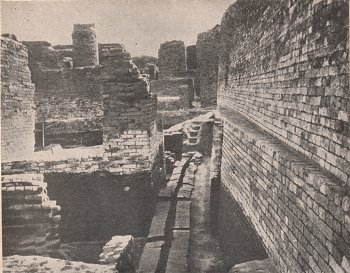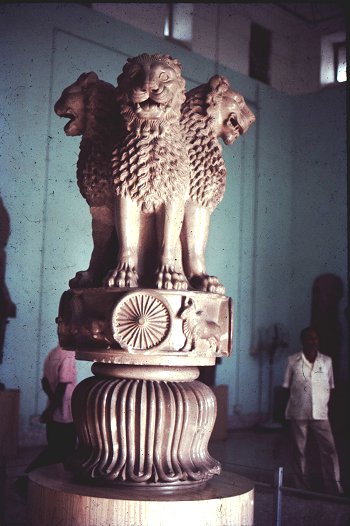5000 Years of Indian Architecture
Perhaps no branch of human culture reflects with greater exactitude the progress or decadence of man than architecture. In the progress of architecture from the most primitive types of human habitation of magnificent temples and palaces, we can discover the ceaseless effort of man to express his social and religious environment and his attitude towards life. In the development of architecture, we can also detect the aesthetic taste which actuated man to combine beauty with utility. The progress of Indian architecture from the primitive to the sophisticated was no exception to this historical process.
The earliest phase of Indian architecture may be seen from the remains of the ancient cities of the Indus Valley culture datable to c. 3000 B.C. From the excavated remains at Mohenjo-daro in Sindh and Harappa in Punjab, it is evident that the Indian cities at that early period were scientifically laid out. There were broad roads and smaller lanes with shops and booths. The houses were probably of the story or more. The roofs were of stamped clay. practically every house had a bathroom which was always placed on the street side of the building for the convenient disposal of water. There was adequate arrangement for drainage. A brick-lined channel flowed down every street and into this main drain ran smaller tributary drains from the houses on either side. An important feather of the drainage system was the provision of large brick culverts with corbelled roofs built on the outskirts of the city to carry away storm water. The houses were also provided with brick-lined wells.
Govt. of India/Kamat's Potpourri
Drainage System at Mojenjo-daro
At Harappa, the remains of one of the structures has twelve parallel walls. We are unable to determine the exact significance of this structure but it might have been a gigantic storehouse. At Mohenjo-daro, some buildings have cup-like depressions at street corners. These depressions probably served as receptacles for large jars.
One of the most important constructions at Mohenjo-daro is the large bath built entirely of burnt bricks which could be entered at either end by means of a staircase. The broad walk at the top of the bath rested on cells filled with clay. There were walls with openings which provided access to a cloistered walk running round the bath. The eight bathrooms, to the north of the bath were provided with stairways probably leading to an upper story. The exact significance of this great bath and smaller baths has not yet been discovered, but it probable that bathing was a ritual with the people of Mohenjo-daro.
The history of Indian architecture between the Indus Valley period, which came to an end some time in the 2nd millennium B. C., and the 4th century B.C. is very meager. We have to depend entirely on literature to fill this gap. From Vedic evidence, it seems possible that the idea of the fortified town was adopted by the Vedic Aryans from their Dasa enemies, though so far it has not been possible to connect these Dasas with the Indus Valley people.
The Vedic house was not a very elaborate affair and the people lived mostly in thatches houses with several rooms. The house was often provided with a central hall and several other rooms which were used for storing and living purposes.
In the epics and Buddhist literature, references are made to will-built cities and sumptuous palaces. These cities and palaces seem to have followed the same plan as that of the city of Pataliputra which, according to Megasthenes (4th century B.C.), occupied a narrow parallelogram and was provided with stupendous palisades with loopholes for archers. There was a deep moat around it. The rampart had as many as sixty-four gates. The royal palace was was a spacious building, the main part of which consisted of a series of hypostyle halls.
V.N. O'key/Kamat's Potpourri
Ashokan Pillar, Sarnath
The architecture of the Asokan period (c. 273-237 B.C.) gains in magnificence, as for the first time stone was employed instead of wood. The great art of the Asokan period is mainly represented by the monolithic pillars on which edicts were engraved. The famous capital of the Sarnath pillar consists of four adorned lions which originally supported the Wheel of Law resting on the abacus bearing in relief an elephant, a horse, a bull and a lion. In other extant examples, the crowning member consisted of a bull or wheel. The pillars were highly polished. There are also excavated halls of the Asokan period in the Barabar hills. Of these, the Sudama cave consists of a circular chamber and an ante-chamber with side entrances. The remains of Asoka's palace at Pataliputra show that it was planned on the model of pillared halls of the Achaemenid kings of Persepolis.
Indian architecture between 200 B.C. and 20 A.D. continued to maintain the progress made in the Asokan period. The improvement in the cave architecture may be seen in the old vihara at Bhaja near Poona datable to 2nd century B.C. It is remarkable for its unique relieves, one of them being identified by Dr. Coomaraswamy as Indra riding his Airavata. Bedsa and other caves near Poona of the same period consist of a nave, apse and aisle, the apse containing a solid stupa and the aisle continuing round the apse, thus providing the circumambulation path.
The Chaitya hall at Karle, which may be dated to the 1st century B.C., is a magnificent example of cave architecture. Its horseshoe windows, great pillars and finely carved relieves win our admiration.
The remains of the railings and gateways of the Bharhut stupa may be dated back to c. 150 B.C. The railing pillars and the gateways are decorated with the figures of the guardian Yakshas and Yakshis, Nagarajas, birth-stories of the Buddha called Jatakas, floral, animal and other motifs. The Buddha himself does not appear and the chief events in his life a represented by symbols.
There was a special type of temple connected with the Bodhi-tree at the Gaya. On the strength of certain reliefs raging from eh 2nd century B.C. to the 2nd century A.D., it could be said that this temple was made of a gallery with vaulted roof and Chaitya windows of the usual type supported by pillars and with the ground plan like a Maltese cross.
The Sanchi stupas are of different periods. The core of the stupa No. 1 was probably built in the Mauryan age. The stupas Nos. 2 and 3 are of Sungan origin and the gateways of the Nos. 1 and 3 belong to the Satavahana period (72-25 B.C.) The reliefs on No. 2 are related to the Bharhut style, but there are some reliefs which exhibit greater knowledge of spatial relation which is attributed to the hypothetical influence of Bactrian Hellenistic art, but its more natural explanation would be the stylistic advance of Indian art.
The reliefs of the Great Gateway are marvels of decorative story-telling. The principal themes are drawn from the life of the Buddha and from the Jatakas. The bigger compositions were attempted on torana architraves.
The excavations at Taxila and elsewhere have provided us with material relating to the development of architecture between 78 and 302 A.D. The architectural style in the monasteries is fundamentally Indian, but numerous motifs, for instance, the Corinthian capital, pediments, entablatures, moldings, etc., are of debased classical order. A typical Gandharan monastery consists mainly of two structures, the stupa and the monastery with the aggregate of other building.
Among the great monuments of the Deccan during this period may be mentioned the Great Stupa at Amaravati which, though originally built in the 2nd century B.C., was provided with sculptured casing slabs and railings in the 1st, 2nd and 3rd centuries A.D. On the drum of the stupa were four projecting offsets facing each of the entrances and each displaying five pillars called Aryaka Kahambhas. The stupa was surrounded by a rail. The subject-matter of decoration are rosettes, garland-carrying erotes, Jataka stories, walled and moated cities, palace buildings, toranas, stupas, etc. The technical proficiency of the Amaravati reliefs makes them the most fascinating and expressive of the rasa of Indian sculpture.
There is little doubt that Indian architecture and sculpture attained their zenith in the Gupta period and are best represented in temple architecture, of which a few examples are given here.
The famous Dhamekh stupa at Saranath near Banaras datable to the 6th century A.D. is characterized by exquisitely carved ornaments, geometrical and floral. The Ajanta monolithic Caves Nos. XVI, XVII and XIX are distinguished for the beauty of their pillars and their facade decorations. The Chaitya windows with their double row of cornices in Cave No. XIX at once attract our attention. A good example of the apsidal temples of the Gupta period is the one at Ter. Among flat-roofed shrines, a prominent place must be given to the flat-roofed temples at Sanchi and Bhumara. The Siva temple at Bhumara consists of a flat roof and decorated windows. It was provided with a variety of richly carved sculptures. The famous Mahabodhi temple at Bodh Gaya, in spite of its restoration, probably maintains its form of the early Gupta period. it consists of a high straight-edged pyramidal tower of nine stories.
![]()

